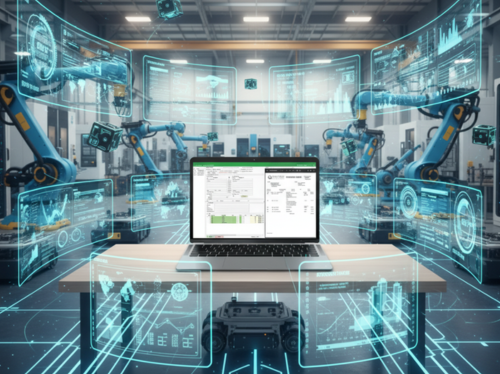Interview : Commitment is key to reaping the benefits of automation

Oliver Selby, Robotics Business Development Manager at FANUC, the global leader in industrial robots, discusses the current hot topics in automation with contributing editor Steed Webzell
The evidence is there to see. According to the 2021 World Robot Report from the International Federation of Robotics, the use of industrial robots in factories around the world is accelerating: 126 robots per 10,000 employees is the new average robot density in manufacturing industries globally – nearly double the number of 2015.
The somewhat disappointing news, however, is that the UK lags behind rival economies such as Japan, Korea, Germany, the US, China, Italy and France. UK robot density is below average at just 101 units per 10,000 employees, giving it a world ranking of 24th, hardly befitting of a world top-10 manufacturing economy. So what exactly is holding the UK back?
“There’s a long-standing misconception that automated solutions including robots take the place of production workers, which is why we need more robotics users to come forward and say otherwise,” states Oliver Selby, Robotics Business Development Manager at FANUC UK. “Most plants find that investment in robotics leads to productivity gains, company growth and, subsequently, the need to employ more people.”
Issues such as post-Brexit labour shortages have prompted some recent investment activity in certain industries, such as food, but it seems this is the exception rather than the rule.
“It’s always ‘next year’ with UK companies,” says Mr Selby. “Manufacturing and process plants here tend to dip their toe in the water, whereas counterparts in mainland Europe throw themselves in. All that said, we believe things are steadily beginning to change, with more companies across all industries now waking up to automation. Enquiry levels are holding steady in the UK and we predict that sales of FANUC robots will be reasonable this year.”
School of thought
Education is another factor at the heart of the UK’s robotics issue, but hopefully this will change with future generations. Robot arms are slowly finding their way into more schools, colleges, universities and training centres.
“At FANUC we’ve had cost-effective educational cell packages available for the past 6-7 years, with increasing uptake, thanks in some part to our role as a sponsor partner of WorldSkills,” says Mr Selby. “WorldSkills organises the world championships of vocational skills every two years, helping young people to prepare for a career in robotics.”
He continues: “We sell around 25 educational cells into the UK every year, with the latest package featuring a FANUC CRX-10iA collaborative robot.”

Connecting the dots
Another hot topic in the robotics arena is digitalisation and the drive towards Industry 4.0 but, according to Mr Selby, the UK is again proving slow off the mark.
“UK companies have trouble relating to the added value that this technology brings,” he says. “We are, however, talking to some UK plants about adopting higher levels of digitalisation via our open-platform FIELD system. With FIELD system apps, companies can monitor measure and analyse data to improve production efficiencies.”
FIELD stands for `FANUC Intelligent Edge Link and Drive`. Notably, this open-platform system can connect robots and machine tools of different generations from all manufacturers.
Time to recharge
Automotive is an industry keen on digitalisation, although for now there is another hot topic dominating the headlines: electric vehicles. Here, the handling of heavy battery packs is a key application for robots.
“The automotive industry’s transition to electric vehicles is high on our agenda,” says Mr Selby. “Hopefully we are seen as the market leader for both battery and EV manufacture, particularly as FANUC is at the heart of all Tesla’s automated production in the US and Germany.”
It is well publicised that the UK is looking to build a number of gigafactories for battery manufacture, most of which are currently in planning.
“If these gigafactories are looking at space and buildings, they should also be looking at the associated automation infrastructure – particularly with the globe’s existing supply chain issues,” says Mr Selby. “If people commit, we will work with them commercially to ensure we manage any risks effectively.”
As a point of note, a new FANUC M1000-iA robot was on show at the recent EMO Milano exhibition handling a heavy battery pack for an electric vehicle as part of an eye-catching robotics area dedicated to green mobility.
Engage and commit
“Another sector where we have global focus is aerospace, although the project cycles are very long,” says Mr Selby. “If aerospace manufacturers require advanced manufacturing technologies they should be engaging with companies like FANUC today to ensure the optimal products are available in five years’ time. Manufacturing technology changes dramatically even over periods as short as 2-3 years: just look at metal additive manufacturing as an example. Engage early, talk to us and make the commitment to ensure both technical and commercial project success.”
A good example in the aerospace industry is the imminent use of FANUC robots for drilling processes.
“We have UK customers in the aerospace sector about to embark on their first drilling cells using FANUC robots that feature dual encoder technology for enhanced positioning accuracy,” says Mr Selby. “After all, if you can put a drill in-situ within drawing tolerance then you are halfway to performing that task with a robot rather than a machine tool. What we are doing here is industry-leading and, like so many robot applications, adds genuine value for customers prepared to commit.”








